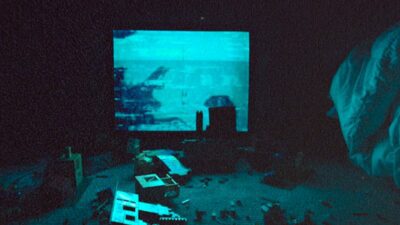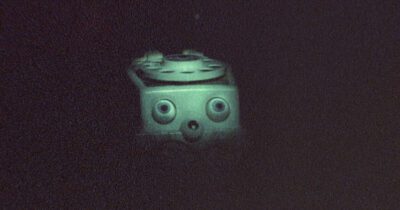Skinamarink is a trippy post-narrative/post-structuralist genre experiment. It does one of the best things a film can do—forcing the audience to question their mode of seeing, thinking, and organizing sensory information. It does so by operating in equivocal zones—at the edge of visual, narrative, and sonic intelligibility. Instead of prioritizing story, it redistributes its units of cinema into a new composition entirely, focusing on ideas, images, and objects with little connective tissue.
This approach to cinema is oddly rarefied, especially among theatrical releases. Outside of David Lynch, and perhaps Apichatpong Weerasethakul, few other popular modern/theatrical filmmakers push the envelope of intelligibility as far as Kyle Edward Ball does here. In many ways, Skinamarink might be considered a pastiche more than a film. It grew out of the YouTube project/channel Bite-Sized Nightmares, wherein Ball uploads videos recounting nightmares. These videos evolved into a 2020 short film Heck, and later formed the underlying concept for Skinamarink.
Whatever the origins, it’s impossible to deny how unorthodox the cinematic syntax of Skinamarink truly is. On the spectrum between concrete realism and abstract indecipherability, it veers far toward the latter. This makes it a thoroughly postmodern film, particularly in the sense of the critical thinker who coined the term, Jean-François Lyotard. According to Lyotard, post-modernity was defined by a decline in the centralizing “Big Narratives” shaping the parameters of meaning in human culture and life.
By moving away from the oppressive weight of genre-based structuralism, Skinamarink becomes something more nebulous and amorphous and psychologically honest. Associative and fragmented, the film is bereft of a grand narrative. Every moment is localized and independent, devoid of a universal thematic throughline. Throughout the film, the familiar turns terrifyingly unfamiliar, dilating into pure abstraction. The continuum of happenings consists of a series of claustrophobic non-sequiturs, a montage of affective spaces confined to a single house.
The effect is somewhat akin to a Guy Maddin film, only without any narration or guidance whatsoever. Throughout, we move around a home with little orientation or anchoring. We stare at whatever the camera focuses on: our field of vision obfuscated by a grainy filter. There are multiple shots of Lego toys scattered about on the carpet, along with other childhood paraphernalia (a juice box, a bowl of sugary cereal, and a Barbie doll). Together, this miscellany centers our primary POV, which is clearly attuned to that of a child.

Through what is ostensibly a child’s fuzzy and unstable perspective, we get a series of visual permutations marrying horror tropes to quotidian household objects. Horror has a long tradition with these two elements: artlessness and domesticity. The innocent gaze and the home are prominent sites of fear and anxiety because they are often associated with a space where we seek refuge and open ourselves to vulnerability. Quite slyly, Skinamarink taps into the granular consciousness of an inchoately formed mind, transporting the viewer to a primitively haunted mindset where danger lurks among the banality of everyday paraphernalia.
To approximate a child’s ingenuous perspective, the camera intimately fixates on things. The cyclical reappearance of specific images allows us to stare at the increasingly familiar milieu from new vantage points. Our mode of interacting and perceiving the domestic setting is constantly reoriented by angular shifts, evolving lighting, emergent objects, and strange interruptions. Methodically, each new shot frames the minutia and shadowy contours of the home’s interior decor / architectural details in a new guise.
Near the end, space flips entirely. We begin to look at the door jambs and door knobs completely upside down as the camera crawls and creeps along the ceiling. In one sequence, we slowly zoom away from a Lego fortress at the end of a hallway, watching the pile of toys slowly recede to a horizon point. It’s hard to tell if the camera is above the Lego fortress, below it, or beside it.
Time dilates, as well: a cryptic subtitle announcing “572 days” appears over the aforementioned Lego fortress. There’s no clue what this timestamp or timespan means. Regardless, these dilations offer the film a multidimensionality and voluminousness that belie its otherwise claustrophobic spatial and temporal dimensions. On one hand, the entire film appears to transpire in a single home over the course of a single night. On another hand, there’s no basis to infer any such assumption. This paradoxical and fractal confusion is precisely the point. We’re left without any epistemic or heuristic explanations or bearing, and thus free to contemplate an infinite number of narrative possibilities out of an ostensibly confined, isolated, and finite visual setting.

Mirroring this destabilizing quality, the granular depths of the distorted/static black imagery form disorienting optical illusions. As the eye stares into the swirling visual snow, patterns and shapes begin to appear. Space begins to unfold and expand as well, forming voluminous three-dimensional depth James Cameron could only dream of capturing.
Complementing this visual fuzz is the constant crackle of the old film stock and the intermittent intrusion of piercing, ambient sounds. Many of the film’s peripheral noises are familiar (a phone ringing, a dial tone, a voice talking, a cartoon sound effect/jangle, heavy breathing, the soft rustling of socks on the hallway carpet). But the sonic familiarity of these discernible sounds is stretched beyond their semiotic boundaries. Elasticized past their practical threshold, they sporadically transform into pure tonalities, creating a sense of cinematic ASMR. They offer hypnotic solace, with an unnerving undercurrent of paranormal disquietude.
Even the old television cartoons shown playing on a television screen become uncannily sinister and creepy. Seemingly programmed to repeat on a loop: we sporadically watch classic images of 1930s animated characters chasing sparrows, popping balloons, and opening an endless stream of doors ad infinitum. There’s both levity and terror, comfort and deafening unease to these cartoon interludes. The old-fashioned hijinks and shenanigans of Pincushion Man and Bugs Bunny in Prest-O Change-O take on an air of nonsensical futility (unless you find hidden meaning to the surrealistic background cartoon choices, like this Reddit analysis). They offer yet another cyclical and meaningless space, stuck in a sort of eternal recurrence of sensory impressions. Meaning seems to behave abandoned the ontological and the mythological. It is solely rooted in the immediacy of the sensory experience.
Language—the brain’s primary tool of sense-making—does emerge intermittently. Brief conversations (usually telephonic and one-sided) can be heard murmuring in the margins and randomly pop up onscreen via subtitles (which emerge randomly, as if winking at the murky/ambiguous shifts in the distance and proximity of the speaker, who in most cases is mostly lost in an indiscernible blur). The net effect of this scattered sensory data is a sense of generalized suspense. As the mind begins quivering and hyperventilating amid the meditative calmness, it enters paranoiac hyperdrive, interpreting every sonic cue or emergent shape as an alarming intruder.

Eventually, the overwhelming impulse is to compile all the assorted and fragmented dialogue to try to build a sensible story. This only proves to be a frustrating enterprise, however, because instead of a coherent series of verbal events, we are merely given audible snippets recounting seemingly secondhand and unrelated conversations. We hear secondhand about a stairwell tumble and a scissor accident/attack and eavesdrop on a 911 call. We also are confronted with cryptic, spectral declarations (“I can do anything!”) and inquiries (“What is your name?”) that speak to our most elemental forms of communication.
The film thus thwarts every attempt at understanding its potential meaning. Instead, it proffers a purposely liminal/enigmatic space and evocative tone designed to evoke and provoke audiences to project their own primordial anxieties and fears upon the screen. Is there a ghost or poltergeist spirit lurking in the hallways? What supernatural powers are disturbing the electricity and sound waves? Or is my mind just conjuring up random musings to fill the non-space and void with a false semiotic topography?
As thrillingly discombobulated as I was, I did extract a quasi-epiphany. At the very least, three of the final shots felt somewhat revealing of Skinamarink’s central thesis. The first consists of blood splattering on the carpet (viewed from the inverted vantage point of the ceiling). After splattering, the blood is suddenly retracted, redacted—intentionally edited out of the scene. The other two shots involve a small tv with digital snow on the screen and a grainy face, both perfectly centered amid a dark background. Put together, these images seem to combine the elemental necessities of horror-based storytelling: artifice, the human visage, and the screen. Nondescript, they seem to suggest that at the heart of any horror story is creative tinkering, a human-infused mood/ambiance, and a medium to convert the characters/setting.
Like this far-fetched reading, the potential inferences one might derive from Skinamarink are arguably never-ending. When left stranded and alienated by a scarcity of information and signposts, most viewers are compelled to build an organic/homegrown world themselves, setting the mind on overdrive to frantically fill in the blanks in vain. This is simply what we’re attuned to do. And by flipping the script, Skinamarink places the arbitrary power of storytelling into the audience’s hands. In doing so, it reminds us that genre tropes and authorship exist in a feedback loop of eternal recurrence between projection and reception, signifier and signified, creator and muse/consumer. We may think we make movies and meaning, but these things ostensibly already exist within us. Spend a few hours staring at ambiguous imagery, and the mind will begin to tap into its stored reservoir of celluloid illusions, forging its own wacky meaning extemporaneously.



